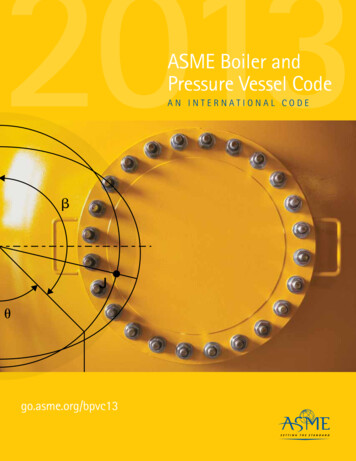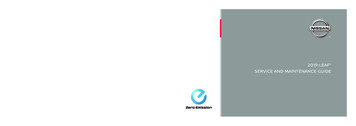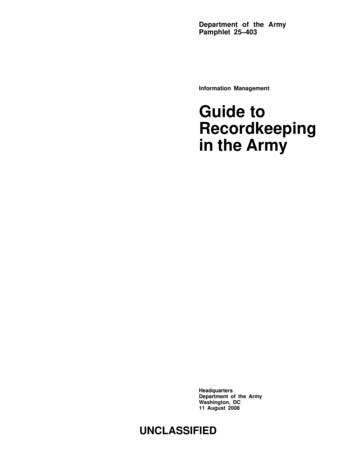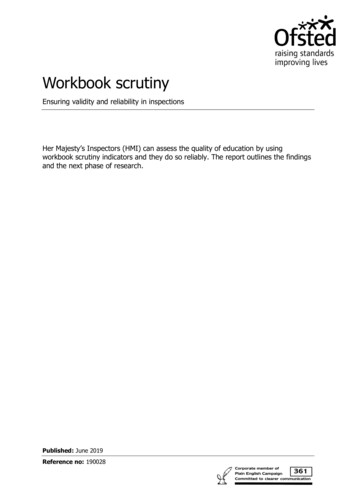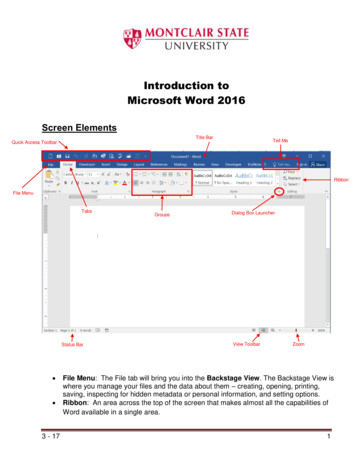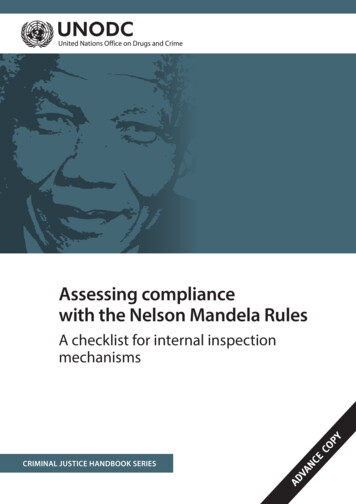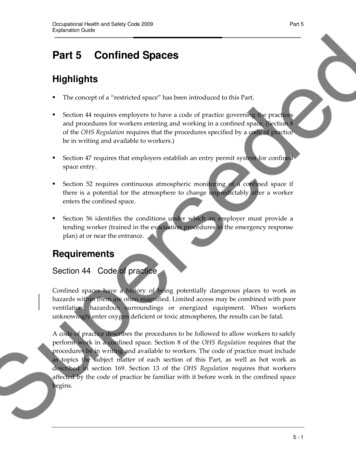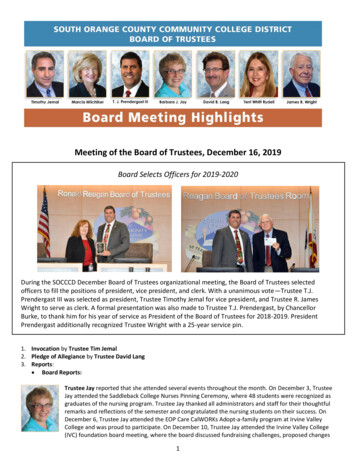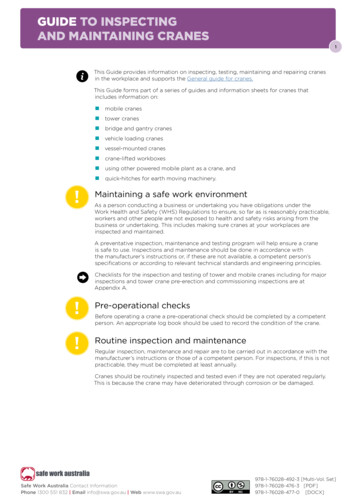
Transcription
GUIDE TO INSPECTINGAND MAINTAINING CRANES1This Guide provides information on inspecting, testing, maintaining and repairing cranesin the workplace and supports the General guide for cranes.This Guide forms part of a series of guides and information sheets for cranes thatincludes information on: mobile cranes tower cranes bridge and gantry cranes vehicle loading cranes vessel-mounted cranes crane-lifted workboxes using other powered mobile plant as a crane, and quick-hitches for earth moving machinery.!Maintaining a safe work environmentAs a person conducting a business or undertaking you have obligations under theWork Health and Safety (WHS) Regulations to ensure, so far as is reasonably practicable,workers and other people are not exposed to health and safety risks arising from thebusiness or undertaking. This includes making sure cranes at your workplaces areinspected and maintained.A preventative inspection, maintenance and testing program will help ensure a craneis safe to use. Inspections and maintenance should be done in accordance withthe manufacturer’s instructions or, if these are not available, a competent person’sspecifications or according to relevant technical standards and engineering principles.Checklists for the inspection and testing of tower and mobile cranes including for majorinspections and tower crane pre-erection and commissioning inspections are atAppendix A.!Pre-operational checks!Routine inspection and maintenanceBefore operating a crane a pre-operational check should be completed by a competentperson. An appropriate log book should be used to record the condition of the crane.Regular inspection, maintenance and repair are to be carried out in accordance with themanufacturer’s instructions or those of a competent person. For inspections, if this is notpracticable, they must be completed at least annually.Cranes should be routinely inspected and tested even if they are not operated regularly.This is because the crane may have deteriorated through corrosion or be damaged.Safe Work Australia Contact InformationPhone 1300 551 832 Email info@swa.gov.au Web www.swa.gov.au978-1-76028-492-3 [Multi-Vol. Set]978-1-76028-476-3 [PDF]978-1-76028-477-0 [DOCX]
GUIDE TO INSPECTING AND MAINTAINING CRANES2Routine inspections can take place weekly, monthly or quarterly and should includean inspection of: crane functions and the controls for speed, smoothness of operation and limitsof motion emergency and safety switches and interlocks including limiting and indicating devices lubrication of moving parts verify accuracy of any load moment indicator (LMI) and rated capacity indicator(RCI) devices with a test lift using a certified test weight filters and fluid levels and leaks visual inspection and measurements as necessary of structural components and criticalparts including brakes, gears, fasteners, pins, shafts, wire ropes, sheaves, lockingdevices and electrical contactors signage including warning signs and control markings wear on wheels and tyres, and extra items nominated in the crane manufacturer’s instructions.A written report should be prepared when the inspection is finished. If replacementparts are needed as a result of the inspection, these parts should meet the original part’sspecification.If a crane has been damaged and there are risks to health and safety, it should beimmediately taken out of service and people prevented from operating the crane. If thecrane needs to be operating during maintenance or cleaning, risk control measures mustenable this to occur without risk to health and safety.!Annual inspectionRegular inspections must be carried out in accordance with the manufacturer’s instructionsor those of a competent person or, if this is not reasonably practicable, annually.An annual inspection may be less comprehensive than a major inspection. It should includeevery item specified by the crane manufacturer for annual inspection and every itemincluded in the routine inspection and maintenance programs.Annual inspections should include a detailed check of: functioning and calibration of limiting and indicating devices structural and wear components tolerances for wear limit evidence of corrosion critical areas for evidence of cracking, and for tower cranes, relevant items in the pre-erection inspection and tests that canbe safely completed while the crane is erected.Where a tower crane owner is aware a crane will be erected when the scheduled annualinspection falls due, the owner can choose to carry out an annual inspection beforeerecting the crane or during the pre-erection inspection.!Major inspectionsA major inspection must be completed for registered mobile and tower cranes.Non-registrable mobile cranes and bridge and gantry cranes should have a regular ‘major’inspection completed so that they continue to be safe to operate.DECEMBER 2015
GUIDE TO INSPECTING AND MAINTAINING CRANES3Major inspections must be carried out at the end of the crane’s design life, as determinedby the manufacturer’s instructions, or if these are not available, as determined by acompetent person to meet the same minimum requirements established by relevanttechnical standards.If it is not reasonably practicable to inspect a crane according to either of these, youshould inspect the crane at least every 10 years from the date the crane was firstcommissioned or registered, whichever was first. This must include inspection of thestructure as well as mechanical components.Major inspections must be carried out by, or under the supervision of, a competent personwho: has acquired through training, qualifications or experience the knowledge and skills tocarry out a major inspection of the plant and is registered under a law that provides forthe registration of professional engineers, or is determined by the regulator to be a competent person.Appendix A lists some items to be inspected during a major inspection for tower andmobile cranes. Some of the items may not apply, for example where the item does notexist on the crane. The full list of items to be inspected must be determined by acompetent person.Completion of a major inspection does not indicate that the components inspected willhave a further 10 year life. It should not be assumed that the items included in the listonly require inspection at 10 yearly intervals. Items will require some type of inspectionand maintenance at more frequent intervals, for example at annual and other inspectionintervals, according to the crane manufacturer’s instructions.Where there is documented evidence that inspection and testing has been carried outon certain items, for example slew ring bolts, drive systems and braking systems, withina reasonable preceding period (as determined by a competent person) the item maynot have to be stripped down in the major inspection. The competent person should stillinspect the safe operation of the item to certify it is operating safely and document thereasons for the decision.!Record keepingCrane records including maintenance logbooks of the significant events concerningthe safety and operation of the crane must be kept and readily available. Recordsshould be kept in a suitable format and must be transferred with ownership of thecrane. Entries in the maintenance logbook should: clearly describe the work carried out and parts replaced be dated note the name of the person carrying out the work, and be signed by the person carrying out the work.The checks, adjustments, replacement of parts, repairs, inspections performed andirregularities or damage concerning the unit’s safe use must be recorded.Inspection records should include a statement from a competent person confirmingthe item of plant has been inspected and is safe to operate.Inspection records should include: What was looked at – component specification or areas of the plant inspected. What was looked for – signs of wear, damage, cracking or corrosion. What criteria were used – rejection criteria. How was it looked for – techniques used. What was found – test results, photographs or measurements.DECEMBER 2015
GUIDE TO INSPECTING AND MAINTAINING CRANES4 What was recommended – repairs required before continued use. What recommendations were actioned – recommendations acted upon and datetasks were completed.!Tower cranesPre-erection inspection and tests—on ground inspectionTower crane components should be inspected and tested by a competent personaccording to the manufacturer’s instructions before being delivered to the workplaceand before being erected.Where a tower crane owner is aware a crane will be erected when the scheduled annualinspection is due, the owner may consider carrying out an annual inspection during thepre-erection inspection.Crane owners should develop their own pre-erection inspection and test report thatsatisfies the requirements of the WHS Regulations and the manufacturer’s instructions.The report should also reflect the specific type and model of crane and reference relevantdesign drawings and test certificates.Commissioning inspection and testsCommissioning inspections and test should be carried out by a competent personaccording to the manufacturer’s instructions before a tower crane is put into service.Non-destructive testing of tower crane componentsNon-destructive testing (NDT) is the testing of materials to detect internal, surface andconcealed defects, cracks, breaks or gaps using methods which do not damage or destroythe material being tested.NDT must be carried out by a competent person having suitable knowledge andexperience in NDT methods and being able to determine the appropriate NDT method forthe component being tested.When using magnetic particle NDT to detect cracks in metals remove the paint from themetal surface. This is not required for Eddy current NDT.NDT of specific tower crane components should take place according to themanufacturer’s instructions and at set intervals, for example pre-erection tests and majorinspection. Table 1 indicates some common minimum frequencies of NDT for particularcrane components.Table 1 Minimum frequency of NDT for particular crane componentsComponent testedNDT descriptionNDT frequencyBoom clevisesCrack testPre-erectionCounterweight sheave bracket welds – movingcounterweights onlyCrack testPre-erectionCruciform welds – luffing cranes onlyCrack testPre-erectionButt heal bosses – luffing cranes onlyCrack testPre-erectionBand brake weldsCrack testPre-erectionSlew ring bolts – where slew ring has to besplit at disassemblyCrack test minimum 10% boltsPre-erectionTower bolts (where applicable)Crack test minimum 10% boltsPre-erectionBoom lacing weldsCrack test minimum 10%Pre-erectionTower sectionsCrack test minimum 10%Pre-erectionAluminium sheavesCrack testPre-erectionDECEMBER 2015
GUIDE TO INSPECTING AND MAINTAINING CRANES5Component testedNDT descriptionNDT frequencySlew ring bolts – slew ringsCrack test bolts5 yearsBoom chord thicknessMaterial thickness testing10 yearsSlew ringCrack test10 yearsHydraulic luffing cylinder gland nutCrack test10 yearsHydraulic luffing cylinder and ram-rod endsand capsCrack test10 yearsA-frame – connector welds on primary chordsCrack test10 yearsA-frame lacing weldsCrack test minimum 10%10 yearsHookCrack test10 yearsWelds on hook trolleyCrack test10 yearsCrack testing of booms and counterweight sheave bracket weldsBooms on non-self-erecting tower cranes are connected by pins passing through male andfemale clevises on the ends of each boom section. Every weld on male and female cleviseson the ends of every boom section should undergo NDT before each crane erection fornon-self-erecting cranes. Magnetic particle testing is the usual methodused for performing these tests.Counterweight sheave bracket welds, butt heal bosses and welds in cruciform area onluffing crane booms are known to crack and should also be crack tested by NDT beforeeach crane erection.Crack testing of band brakesOlder designs of luffing tower cranes use band brakes. On some of these cranes the steelband is welded to an end fitting that has a pin passing through it. These welds have beenknown to crack.You should crack test the weld between the band and the end fitting by NDT before eachtime a luffing tower crane fitted with band brakes is erected, keeping in mind there maynot be a weld on some brake bands.Crack testing of slew ring boltsThe integrity of slew ring bolts is critical for making sure both the machine deck and boomremain attached to the tower. Once removed, slew ring bolts should be replaced unless themanufacturer’s instructions state they can be reused. If bolts can be reused they should betested.For tower cranes where the slew ring needs to be split each time the crane is moved,NDT 10 per centof slew ring bolts is suggested. Bolts to be tested should be selected from the slewring by a competent person. Complete removal of the bolts from the slew ring and useof magnetic particle testing is recommended. If cracks are detected, bolts should bediscarded and replaced with new bolts.Crack testing of tower bolts or pinsTower bolts or pins are a critical part of the crane and permit the effective transfer of loadfrom the crane boom to the crane base. Tower bolts or pins can become damaged andtheir effective life can be reduced if the bolts are either under or over-torqued. Some towerbolts are made from extremely high grade steel and can be more susceptible to cracking.Unless the manufacturer’s instructions state tower bolts can be reused, they should bereplaced. If bolts can be reused, crack test a minimum of 10 per cent of tower bolts byNDT before each crane erection. If cracks are found, tower bolts should be discarded andreplaced with new bolts.DECEMBER 2015
GUIDE TO INSPECTING AND MAINTAINING CRANES6A system that makes sure tower bolts or pins are tested over time is preferred. Howevera random system of testing can also be used. The tested bolts should be identified bya method that does not damage the bolt.Chord thickness testingSteel lattice-type tower crane booms can be prone to internal and external corrosionaffecting the thickness of the boom. The thickness of the chord wall can be reducedthrough abrasive blasting of the boom.Main chord sections on tower crane booms should undergo thickness testing at intervalsnot exceeding 10 years. Ultrasonic thickness testing is one method of verifying the strengthin the chords of the boom.Review chord sections for structural adequacy when the thickness is shown by testingto be 90 per cent or less than 90 per cent of the original thickness.Further informationThe following technical standards provide further information on inspecting andmaintaining cranes: AS 2550.1-2011: Cranes, hoists and winches—Safe use Part 1: General requirements AS 2550.3-2002: Cranes, hoists and winches—Safe use Part 3: Bridge, gantry, portal(including container cranes) jib and monorail cranes AS 2550.4-2004: Cranes, hoists and winches—Safe use Part 4: Tower cranes AS 2550.5-2002: Cranes, hoists and winches—Safe use Part 5: Mobile cranes AS 2550.11-2004: Cranes, hoists and winches—Safe use Part 11: Vehicle-loading cranes,and AS 2550.20-2005: Cranes, hoists and winches—Safe use Part 20: Self-erecting towercranes.DECEMBER 2015
APPENDIX A – INSPECTION / TESTINGFOR TOWER AND MOBILE CRANES7Inspection / testing for tower cranesPre-erection inspections / testsCommissioning inspections / testsMajor inspectionNDT of welds on vital componentsincluding boom clevises, butt heelbosses and counterweight rope sheavebracketsCrane electricity supply—where usedSlew RingCrane base weights or ballast—whereusedHydraulic motorsNDT of tower crane boltsTower section identification andentryNDT of slew ring boltsNDT of aluminium sheavesThe condition of the power supplycable—where usedThe condition of motor brakesThe condition of the slew ring gear andpinionsAir controls and associated valvesThe condition of ropes and sheaves e.g.erecting, hoisting, counterweight andtrolley, correct rope tracking and nosigns of damage or excess wearThe condition of limit switches andlimiting devicesThe condition of counterweightsThe condition and fitment of machineryguardingBrake systems can be dismantled andinspected for wear and damage: dry brakes—before each erection ormore frequently if directed by themanufacturer wet brakes—before each erection orafter 5 000 hours of crane operationor as directed by the manufacturerNormal service items including itemssupplied by the crane manufacturer e.g.temperature control units and seatingbeing maintained in a serviceablecondition according to the cranemanufacturer’s instructions, andOther tests as specified by themanufacturer.Once the tower crane components havebeen delivered to the workplace theyshould be inspected by a competentperson for possible damage andwear that may have occurred duringtransport. Inspections should include:The crane base design and engineer’sreportCrane ties and structure to supportthem where usedThe power supply and earthing.Tower bolts to correct tensionPins and fasteningsClimbing frame and connectionJib connection pins and retainersA-frame connections and retainers—where applicableJib and deck pendant pins andretainers—where usedMachinery guardingLeakage in lines, tanks, valves, pumpsand other parts of air or hydraulicsystemsThe condition of the ropes andsheaves e.g. erecting, hoisting, trolleyand counterweight, and correct ropetrackingHydraulic pumpsValve blocks(bodies)Hoist and luff drumsBraking systemsRope sheavesHydraulic luffingcylinderGear boxes anddrive shaftsBoomA-framePins with movingparts for example,boom heel pins andram pinsStatic pinsSteel wire ropesIsolating switchesThe condition and phase of thepower supply cableVerification the crane wiringcomplies with AS/NZS 3000:2007:Electrical installationsEffective operation of controlsincluding interlocksEffective operation of indicatingdevicesEffective operation of traveldeceleration switchesEffective operation of hoist upperand lower—where needed—workinglimit switchesEffective operation of warningdevicesEffective operation of weathervaningEffective operation of the hoist andtravel brakes when the crane is ladento the maximum rated capacityEffective operation of the rescuecontrolled descent deviceOther tests specified by the cranemanufacturer.DECEMBER 2015
APPENDIX A - INSPECTION / TESTING FOR TOWER AND MOBILE CRANES8Inspection / testing for mobile cranesMajor inspectionChassis including outriggers and boxesDrive train and suspension componentsSlew ringSlew ring boltsHook rollersDrive systems including winches, hydraulic motors, gearboxes and drive-shaftsControl systemsBraking systemsElectrical systemsHydraulic systems—cylinders including outrigger cylindersBoomsSafety devices including rated capacity limiters and load indicatorsOutriggersSteel wire ropes, andRope sheaves.Electrical systems—hazardous voltageControl systems—non-hazardous voltageElectric motorsHook assemblyDECEMBER 2015
Counterweight sheave bracket welds, butt heal bosses and welds in cruciform area on luffing crane booms are known to crack and should also be crack tested by NDT before each crane erection. Crack testing of band brakes; Older designs of luffing tower
